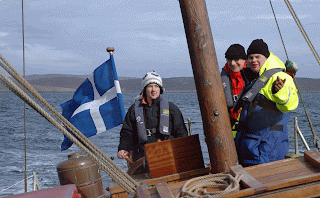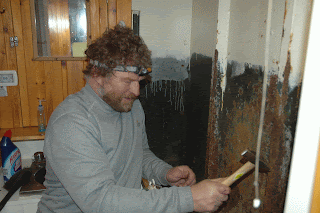Scott
and I had a satisfying week. After
endless shopping (typically a 15 mile round trip) to secure the often minor but
essential items to complete a job, Friday saw a coming together of
endeavour. It also saw the last minute
“crisis” when the engineer appeared with a water intake pipe in his hand with a
broken fitting. Fortunately the seacock
closed and the vessel was not about to sink.
At a minor level it produced an inconvenience of no generator whilst
also bringing into sharp focus some rather more critical issues.
Fortunately
all came together in time for a weekend of staff training. Unfortunately the weather Gods hadn’t read
the script and contrived to foil the intention of a weekend away.
The result was another very enjoyable day sail followed by a good force
8 overnight blow from the west and then for some a day alongside for more
training.
The
volunteer sea staff come from an eclectic background and bring a wide array of
relevant skills and experiences. Some
have spent a life time at sea, although not necessarily under sail; it might be
fishing or in the merchant navy, perhaps with local coastal experience or vast ocean
voyaging. Others have relevant shore
based experience, perhaps with the coastguard or similar. A few are experienced yachtsman, including
one who has sailed his own boat to The Antarctic Peninsula, but they are the
minority. Others are at various stages
of gaining RYA qualifications (as required by MCA regulations) but Swan is not
a yacht or even like one. It makes for a
diverse range of crew experiences and sometimes debate which reinforces the
importance of learning from each other.
It also poses a few challenges for me.
The most daunting is that as skipper, I have a responsibility to
“decide” and lead. Take a very simple
issue; how to tie off a cleat. There are
a host of ways; too many to list here, all have their advocates and
advantages. Again it’s a “small issue”
but the ship is fundamentally safer if everyone is using the same system, it
makes it far easier to see if something is wrong and at 0300 “on a dark and
stormy night” it might be very important that when you go forward to adjust a
line tied by someone else who is now off watch, you know exactly what you are
going to find. No escaping my
responsibility to define the method but far harder to achieve consensus to
enact.
One
of our projects this week had been getting the inflatable tender ready for
work. Its included splicing lifting
strops (a lesson learned from Fred’s boating excursion) , testing the outboard,
making up a tender pack including spares, flares, tools, first aid and the
like) this gave us a first class opportunity to sail out of the harbour with
Nat (who is a photographer) and Scott in hot pursuit for the photo opportunity
of Swan under sail. It also gave me
something to think about whilst sailing in close quarter. (I admit to leaving the engine running but
point out that given my “baby skipper” status that is prudent rather than
cowardice.)
Recovering the inflatable was not as smooth as I had hoped. I’d miscalculated on a fundamental issue and forgotten how much harder this would be underway. I’d also planned the recovery in such a way that we couldn’t easily use the winch to assist. Both were valuable lessons but I also had the distinct impression that my mistakes were the subject of close scrutiny by the more experienced members of the crew, particularly if I hadn’t supported their particular preference in how to tie off a cleat!!
Recovering the inflatable was not as smooth as I had hoped. I’d miscalculated on a fundamental issue and forgotten how much harder this would be underway. I’d also planned the recovery in such a way that we couldn’t easily use the winch to assist. Both were valuable lessons but I also had the distinct impression that my mistakes were the subject of close scrutiny by the more experienced members of the crew, particularly if I hadn’t supported their particular preference in how to tie off a cleat!!
Close
scrutiny of Google maps does not allow for easy access to our route but heading
north up the coast from Scalloway you will find Stromness Voe (named). The voe to the east (unnamed on the map) is
Whitness Voe. For a better feel switch
to the satellite image. Half way up its
length you will notice Kirk Skerry a rock that presents what is sometimes euphemistically
called “ a hazard to navigation”. Relax –
we missed it!! It did however provide a
worthwhile mark to round and some sharp tacking practice to get back down the
Voe into a rising wind before returning to Scalloway and doubling the mooring
lines!! That evening there was a good
blow outside and a good blowout below.
Ruins at the entrance to WhitnessVoe. this beach was a salting where fish were landed, salted and dried
Following the Bowsprit up Whitness Voe
looking up the mast hoops, a traditional way of climbing aloft
The decision not to sail on Sunday might be regarded as over cautious but on balance I think it was the right call. Two of my previously articulated maxims are “always have contingency” and “listen to your doubts”. Successful risk management is in part about weighing risks and benefits. Swan and I are still in our work up phase for the season and I know that not everything is yet as it should be, that includes my state of preparedness and hers; better to conduct alongside training then court an epic . . . .!!
So
on Sunday we focused on some rope and knot work as well as some deck work and
sequencing of bowsprit and jib drills.
It
was an interesting weekend, I made some mistakes but learned much more – and not
just about sailing and weather.
Heading for home on Saturday evening ahead of the closing gale























